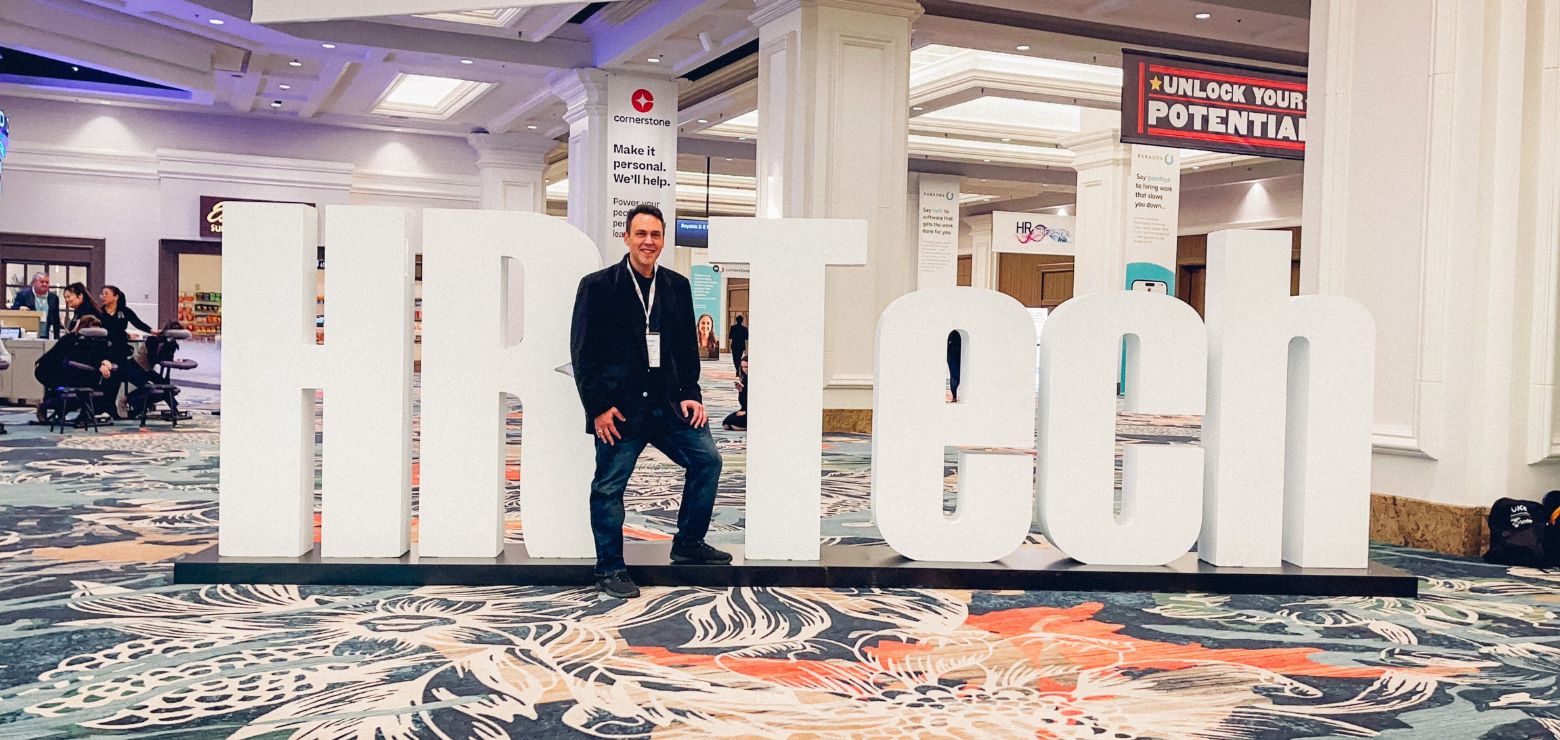By Greg Belkin, Senior Director, Product Marketing
Artificial Intelligence (AI), data integration, and the employee experience were key focal points.
HR Tech 2023 is in the books! This year’s HR Technology Conference and Exposition was, once again, packed from top to bottom with organizations looking to utilize technology and data to improve the candidate and employee experience.
The agenda covered traditional topics, such as “Rethinking your Techstack: How to Prioritize Investments in the Face of Headwinds and Challenge,” as well as new topics like “How AI Will Transform the Market Forever.”
This event was an excellent way to bring together HR practitioners and the IT teams who support them. Strong tech stacks and good data management leads to better decision-making, and that’s key to managing both today’s challenges and tomorrow’s uncertainties.
Here are 5 key takeaways from HR Tech 2023:
-
HR practitioners are largely embracing AI, rather than running from it
There is a lot of concern around AI and how it will alter the human experience. But that was not the sentiment at HR Tech. Attendees expressed excitement and positivity around AI’s potential effect on certain areas of the employee experience.
Several early stage opportunities for the use of artificial intelligence were discussed, including automating data gathering and disbursement requirements that often burden HR teams. Fredd Goff, CEO of JobCase, called out how AI can easily be utilized as a digital coach in the talent acquisition space to respond to transactional issues, such as benefits and organization-wide questions and answers, in a session titled “Growing with People-first Practices in the New Age of AI.”
The key to success with AI, however, is the data sources that stand behind it. Generative AI enables more conversational workflows and faster processes, but its power is meaningless without the proper integrations to the data sources needed to back it up.
-
Employee and candidate empowerment is (still) a prime focus
The keynote may have spotlighted AI, but the rest of the agenda focused on how technology is evolving to enable a top-notch employee, candidate, and HR practitioner experience. Many discussions revolved around the fact that, in today’s modern workplace, the balance of power has dramatically shifted away from traditional corporate workforce management practices, and toward employees who are using the power of choice to redefine a new normal.
Globalization, world health, politics, information accessibility, and lack of available human talent to fill vacant jobs has challenged the way employers approach the entire lifecycle of the employee experience. Event speakers offered two critical strategies to respond to this new normal:
- Understand your workforce: Organizations need a detailed, single view of their entire workforce to help identify talent and employee demographics across all geographies, strengthen growth and development initiatives, minimize shortcomings during health emergencies, and accelerate the identification of gaps in critical roles throughout the organization.
- Treat employees like consumers: Organizations must approach the employee experience with same service and value as they do their customers. Just like when they go shopping, prospective and current employees have lots of options available to them that are easily discoverable. Employers should utilize specific HR data from key systems of record to continuously personalize and optimize the employee experience – or they run the risk high attrition and the incompletion of critical corporate goals.
-
Data integration is a key enabler for employee empowerment and AI engagement
Microsoft’s GM of HR digital strategy, Prerna Ajmera, led HR Tech’s opening session. She theorized that technology, whether new or commonplace, is often less a solution and more an accelerator. Technology (including AI) requires data from multiple sources to function properly, especially in a world of copious HR data.
HR-related data is generated from multiple interactions across various touchpoints, such as internal messaging applications, candidate interactions via email and job posting sites, employee review sites, and more. This data is typically stored across systems like candidate recruitment solutions, onboarding platforms, HR information management platforms, learning and development tools, etc. By integrating these systems, you can connect the touchpoints between employee and customer interactions, “mapping” and automating a workflow to create a better understanding of your employees and candidates (who they are, where they are, how they like to interact with you, etc).
Data integration is the basic building block of a good AI strategy, helping to identify the actionable insights needed to build personalized experiences for an engaged workforce.
-
Creating a well-balanced workforce requires good data aggregation and analysis
Diversity was a hot topic. There was a lot of discussion around gender, race, sexual orientation, age, and religious representation in the workplace. Much of the first day was dedicated to a “Women in HR Tech” summit, focusing on skills-based strategies for empowering women in the workplace and encouraging gender diversity.
The many sessions emphasizing the importance of a well-balanced workforce were all carried by a common theme: utilizing good data for good decision-making. Pay equity, for instance, starts by aggregating and analyzing data across your existing workforce, and marrying that data with industry pay trends. Similarly, good analysis and data aggregation helps organizations strengthen their diversity and inclusion efforts.
-
Most organizations still have a long way to go to optimizing the employee experience
Many attendees of HR Tech 2023 echoed a strong desire to optimize the candidate and employee experience in 2024 and beyond. Yet, many of those attendees admitted their organization has a long way to go before they reach their automation and optimization goals.
Data collected from Jitterbit’s recent 2023 State of HR Automation: The Promise of a Consumer-Grade Employee Experience is Finally Becoming Reality survey corroborates this sentiment. Only 11% of all survey respondents perceived their HR department as having the highest level of automation in their organization. At the same time, however, 50% of organizations indicated that the human resources department is a top priority for business process automation. With the exception of the IT department, HR was the most popular choice among respondents.
Making HR workflows easier with data integration
To create exceptional employee experiences, organizations must integrate HR systems and automate tedious processes throughout the entire employee lifecycle, from candidate management to onboarding, asset procurement, expense management, learning, development, succession, and offboarding. Connecting these key systems also eliminates data silos and accelerates processes between recruitment, HR, finance, and operations teams.
Rather than relying on internal resources to develop data integrations, we offer a complete toolkit of pre-built connectors, recipes, and process templates so you can:
- Connect systems and automate critical business processes
- Get a single view of the employee in one place
- Strengthen employee experiences
- Connect workforce touchpoints across SaaS, on-prem, and other data sources
- Better understand behaviors, increase productivity, and improve employee morale



